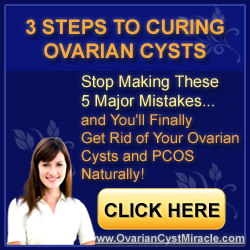Important Facts About Ovarian Cysts Every Woman Should Know About
The symptoms of ovarian cysts belong to the field of gynecology. An ovarian cyst is an abnormal structure in the ovaries, with the appearance of a bubble-like extension that is filled with watery or thick discharge. The classification of cyst types is characterized in functional cysts and their sub-species, the so-called retention cysts, which may be innate.
For women who suffer from ovarian cyst symptoms it is extremely essential to know further details about the disease. Sometimes it can be hard to determine the presence of ovarian cysts, as well as the changes that indicate the existence of small myomas.
Generally, the main symptoms of ovarian cysts can only be felt once the growth reached a certain size. The cysts are usually so small that women do not notice them and remain free of symptoms. Whenever ovarian cysts attain a specific volume they start pressing against adjacent organs; thus cause painful sensations. This discomfort is often described as a dull and dragging feeling in the lower abdomen.
Frequent urination, distress with defecation, pain during sexual intercourse and back pain are typical symptoms. In that case, a clarification by a doctor must be made as soon as possible, as acute and colicky pain may be indicative of complications.
Nonspecific symptoms are constipation, difficulty in urination, urinary retention in the kidneys or a water accumulation in the abdominal cavity. If the myomas produce neoplasm hormones, the patient may experience irregular menstrual cycles, as well as the absence of bleeding or continuous bleeding. Also, drawing pains in the right or left lower abdomen are sometimes a sign of ovarian cysts.
In extreme cases, cysts may rupture or tear. Small herniated ovarian cysts often cause no pain, whereas large bursting cysts can result in sever agony in the lower abdomen. If blood vessels get injured, then it can come to strong bleeding in the abdominal cavity, requiring rapid treatment.
The so-called stem rotation of an ovary must be attended immediately, as the twisted ovary prevents blood from flowing and later on is causing a hemorrhage. This always leads to sever pain, nausea and vomiting. The shaft rotation symptom is more common in medium-sized cysts, and if it is not treated instantly the ovary dies. Overall, these complications are extremely rare; however, they require immediate surgery.
==>Click Here To Learn More About Ovarian Cyst Miracle System
After a medical interview about current ovarian cyst symptoms and associated problems, the doctor performs a physical examination. Through a pelvic exam, he can feel large cysts and tumors effortless.
It is vital that the patient provides the physician with detailed information about possible irregularities in menstruation, existing conditions, pregnancy and previous diseases. A clear insight into the individual’s overall health and lifestyle enables the doctor to make a quick diagnosis, as well as to find the ideal treatment option.
Learn how to eliminate ovarian cyst naturally with the popular Ovarian Cyst Miracle Program by Carol Foster.
